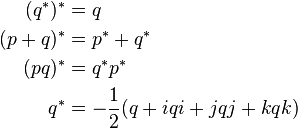Difference between revisions of "Basic properties of quaternions"
(→Conjugate) |
|||
| Line 60: | Line 60: | ||
qq^{-1} = q\frac{q^*}{|q|^2} = \frac{qq^*}{qq^*} = 1 | qq^{-1} = q\frac{q^*}{|q|^2} = \frac{qq^*}{qq^*} = 1 | ||
</math> | </math> | ||
| + | |||
| + | |||
| + | [[Category:Article]] | ||
| + | [[Category:Quaternion]] | ||
Revision as of 16:23, 4 September 2015
| ← Back: Quaternions | Overview: Quaternions | Next: Pure and unit quaternions → |
Imaginary part
The imaginary units of a quaternion are defined as follows:
Unlike the multiplication of real or complex numbers, the multiplication is not commutative:
Conjugate
The conjugate  of a quaternion
of a quaternion  is obtained by negating the imaginary or vector part, respectively:
is obtained by negating the imaginary or vector part, respectively:
Multiplying a quaternion with its conjugate like described in the subarticle about multiplication of quaternions consequently leads to
The conjugate can be used to easily determine the real part and the imaginary part of a quaternion:
The most important properties of the conjugate are:
Norm
The norm of a quaternion corresponds to its euclidean length in four-dimensional space and is computed as follows:
It holds:
Inverse
The inverse of a quaternion is defined as follows:
This can be proven by multiplying a quaternion  with its inverse using the definition of the norm:
with its inverse using the definition of the norm:









